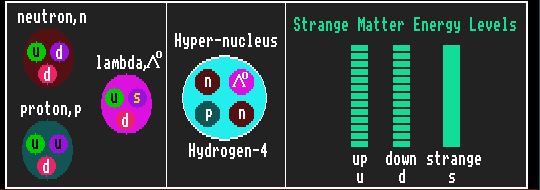

A lambda particle, which has a halflife of 10-10 seconds, is a baryon containing an up, down and strange quark, and, like the neutron, has zero charge and decays by a process analogous to beta decay via the weak force. In beta decay one of the up quarks in a neutron (uud) changes into a down quark producing a proton (udd) (plus an electron and neutrino). In a lambda particle (uds), the strange quark becomes a down quark producing a proton (udd) (plus a muon or heavy electron and muon neutrino). Because strange particles decay by the weak force mediated by the massive W+ or W- particles and not by the strong force, their lifetimes last 1012 times longer than they would otherwise. Hyper-nuclei contain lambda particles as well as protons and neutrons, thus hyper hydrogen-4, with a halflife of 10-10 seconds, has two neutrons, a proton and a lambda particle.
It is theorised that the extreme gravity within a neutron star could stabilise strange quarks against decay, the 'neutron' star would consist of a sea of free-to-roam up, down and strange quarks in mutual equilibrium: Being fermions, the up and down quarks fill two continuous energy bands from the bottom upwards. When the energy level for an addition up or down quark exceeds that of the much heavier strange quark, it becomes energetically favourable to start filling a new band with strange quarks. Such matter, if it exists, is called strange matter. Neutrons would populate the outer layer of the neutron star where the pressure is not so great as to stabilise strange quarks against decay.
![]()